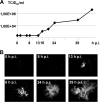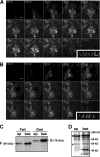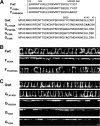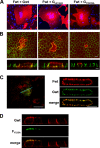Tyrosine residues in the cytoplasmic domains affect sorting and fusion activity of the Nipah virus glycoproteins in polarized epithelial cells
- PMID: 20484517
- PMCID: PMC2897613
- DOI: 10.1128/JVI.02576-09
Tyrosine residues in the cytoplasmic domains affect sorting and fusion activity of the Nipah virus glycoproteins in polarized epithelial cells
Abstract
The highly pathogenic Nipah virus (NiV) is aerially transmitted and causes a systemic infection after entering the respiratory tract. Airway epithelia are thus important targets in primary infection. Furthermore, virus replication in the mucosal surfaces of the respiratory or urinary tract in later phases of infection is essential for virus shedding and transmission. So far, the mechanisms of NiV replication in epithelial cells are poorly elucidated. In the present study, we provide evidence that bipolar targeting of the two NiV surface glycoproteins G and F is of biological importance for fusion in polarized epithelia. We demonstrate that infection of polarized cells induces focus formation, with both glycoproteins located at lateral membranes of infected cells adjacent to uninfected cells. Supporting the idea of a direct spread of infection via lateral cell-to-cell fusion, we could identify basolateral targeting signals in the cytoplasmic domains of both NiV glycoproteins. Tyrosine 525 in the F protein is part of an endocytosis signal and is also responsible for basolateral sorting. Surprisingly, we identified a dityrosine motif at position 28/29 in the G protein, which mediates polarized targeting. A dileucine motif predicted to function as sorting signal is not involved. Mutation of the targeting signal in one of the NiV glycoproteins prevented the fusion of polarized cells, suggesting that basolateral or bipolar F and G expression facilitates the spread of NiV within epithelial cell monolayers, thereby contributing to efficient virus spread in mucosal surfaces in early and late phases of infection.
Figures






Similar articles
-
Nipah virus infection and glycoprotein targeting in endothelial cells.Virol J. 2010 Nov 8;7:305. doi: 10.1186/1743-422X-7-305. Virol J. 2010. PMID: 21054904 Free PMC article.
-
Nipah virus entry and egress from polarized epithelial cells.J Virol. 2013 Mar;87(6):3143-54. doi: 10.1128/JVI.02696-12. Epub 2013 Jan 2. J Virol. 2013. PMID: 23283941 Free PMC article.
-
A single amino acid change in the cytoplasmic domains of measles virus glycoproteins H and F alters targeting, endocytosis, and cell fusion in polarized Madin-Darby canine kidney cells.J Biol Chem. 2001 May 25;276(21):17887-94. doi: 10.1074/jbc.M010183200. Epub 2001 Feb 28. J Biol Chem. 2001. PMID: 11359789
-
Molecular characteristics of the Nipah virus glycoproteins.Ann N Y Acad Sci. 2007 Apr;1102:39-50. doi: 10.1196/annals.1408.003. Ann N Y Acad Sci. 2007. PMID: 17470910 Review.
-
Envelope-receptor interactions in Nipah virus pathobiology.Ann N Y Acad Sci. 2007 Apr;1102(1):51-65. doi: 10.1196/annals.1408.004. Ann N Y Acad Sci. 2007. PMID: 17470911 Free PMC article. Review.
Cited by
-
Nipah virus fusion protein: Importance of the cytoplasmic tail for endosomal trafficking and bioactivity.Eur J Cell Biol. 2015 Jul-Sep;94(7-9):316-22. doi: 10.1016/j.ejcb.2015.05.005. Epub 2015 May 30. Eur J Cell Biol. 2015. PMID: 26059400 Free PMC article.
-
A functional henipavirus envelope glycoprotein pseudotyped lentivirus assay system.Virol J. 2010 Nov 12;7:312. doi: 10.1186/1743-422X-7-312. Virol J. 2010. PMID: 21073718 Free PMC article.
-
Mutations in the cytoplasmic domain of the Newcastle disease virus fusion protein confer hyperfusogenic phenotypes modulating viral replication and pathogenicity.J Virol. 2013 Sep;87(18):10083-93. doi: 10.1128/JVI.01446-13. Epub 2013 Jul 10. J Virol. 2013. PMID: 23843643 Free PMC article.
-
Comparison of the pathogenicity of Nipah virus isolates from Bangladesh and Malaysia in the Syrian hamster.PLoS Negl Trop Dis. 2013;7(1):e2024. doi: 10.1371/journal.pntd.0002024. Epub 2013 Jan 17. PLoS Negl Trop Dis. 2013. PMID: 23342177 Free PMC article.
-
Morbillivirus and henipavirus attachment protein cytoplasmic domains differently affect protein expression, fusion support and particle assembly.J Gen Virol. 2016 May;97(5):1066-1076. doi: 10.1099/jgv.0.000415. Epub 2016 Jan 26. J Gen Virol. 2016. PMID: 26813519 Free PMC article.
References
-
- Bello, V., J. W. Goding, V. Greengrass, A. Sali, V. Dubljevic, C. Lenoir, G. Trugnan, and M. Maurice. 2001. Characterization of a di-leucine-based signal in the cytoplasmic tail of the nucleotide-pyrophosphatase NPP1 that mediates basolateral targeting but not endocytosis. Mol. Biol. Cell 12:3004-3015. - PMC - PubMed
-
- Benedicto, I., F. Molina-Jimenez, O. Barreiro, A. Maldonado-Rodriguez, J. Prieto, R. Moreno-Otero, R. Aldabe, M. Lopez-Cabrera, and P. L. Majano. 2008. Hepatitis C virus envelope components alter localization of hepatocyte tight junction-associated proteins and promote occludin retention in the endoplasmic reticulum. Hepatology 48:1044-1053. - PubMed
-
- Bonaparte, M. I., A. S. Dimitrov, K. N. Bossart, G. Crameri, B. A. Mungall, K. A. Bishop, V. Choudhry, D. S. Dimitrov, L. F. Wang, B. T. Eaton, and C. C. Broder. 2005. Ephrin-B2 ligand is a functional receptor for Hendra virus and Nipah virus. Proc. Natl. Acad. Sci. U. S. A. 102:10652-10657. - PMC - PubMed
-
- Bonifacino, J. S., and L. M. Traub. 2003. Signals for sorting of transmembrane proteins to endosomes and lysosomes. Annu. Rev. Biochem. 72:395-447. - PubMed
Publication types
MeSH terms
Substances
LinkOut - more resources
Full Text Sources
Other Literature Sources

